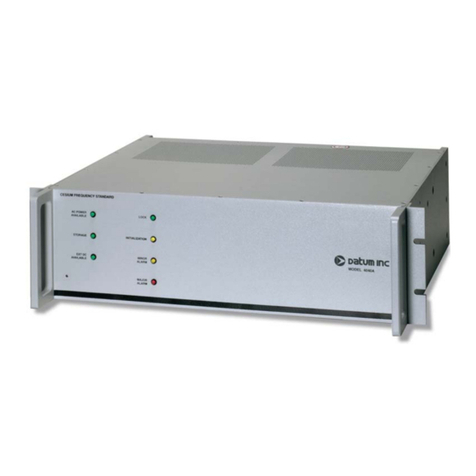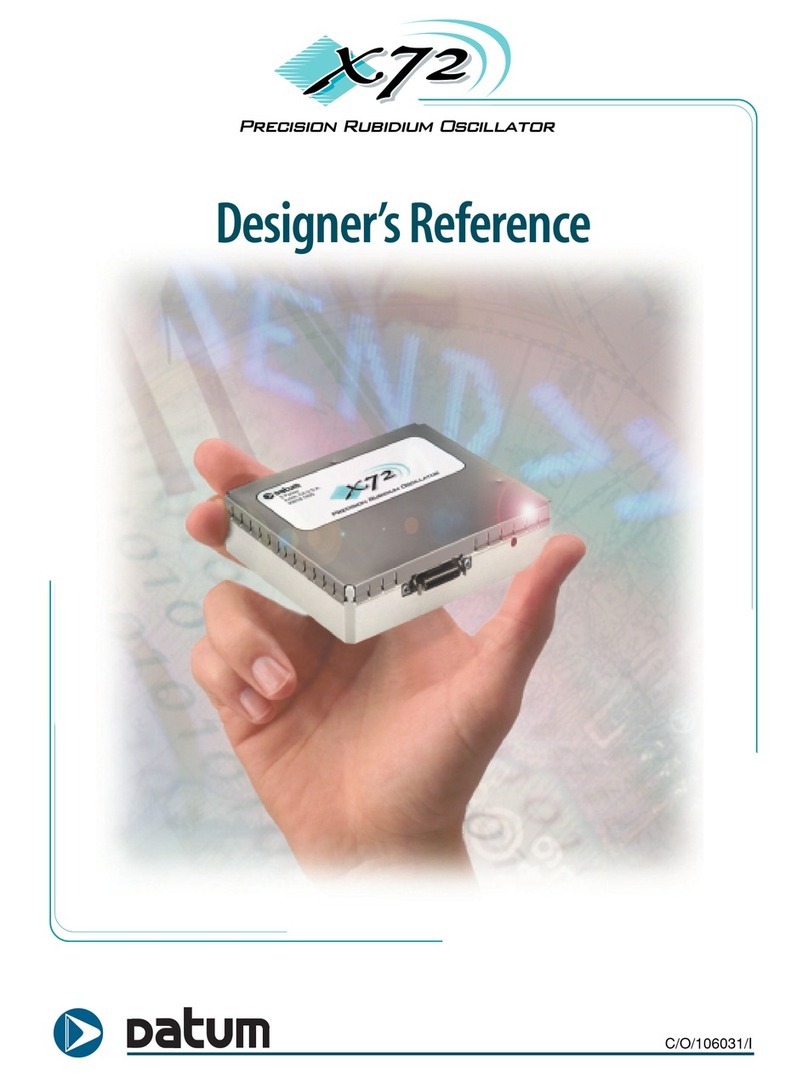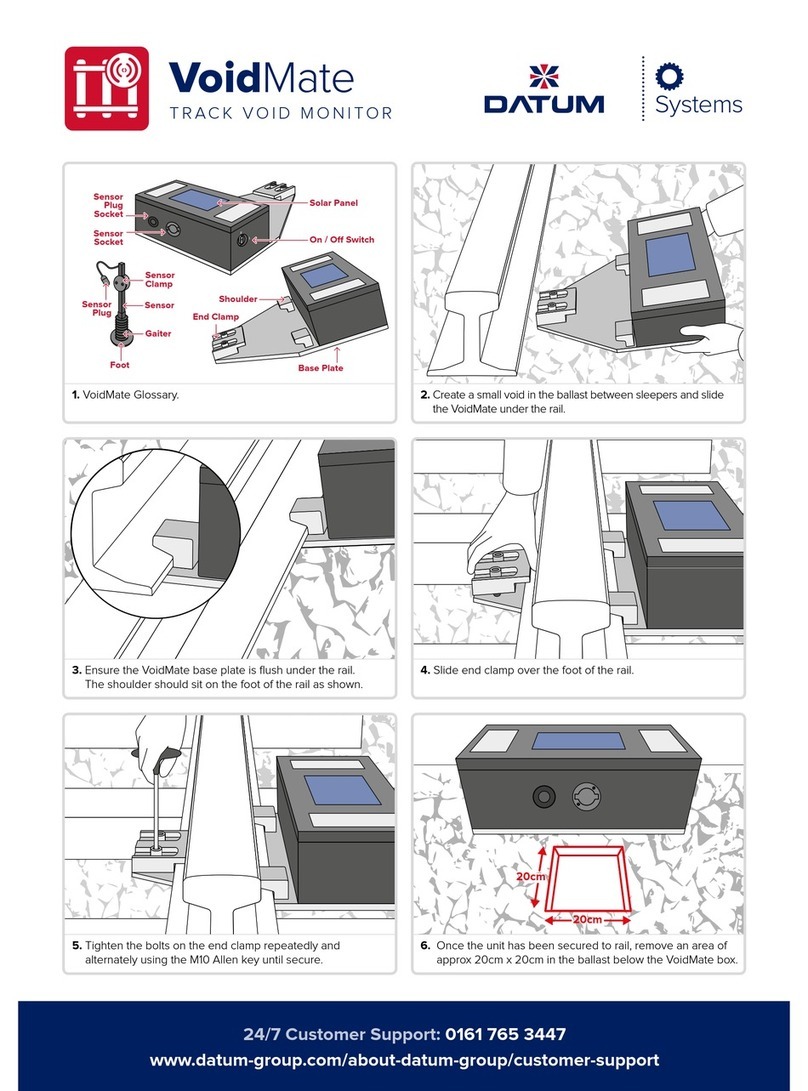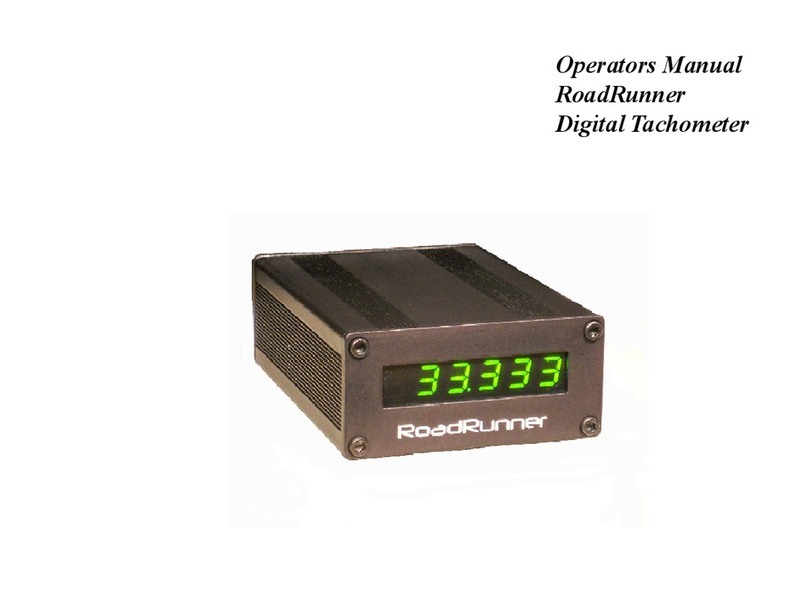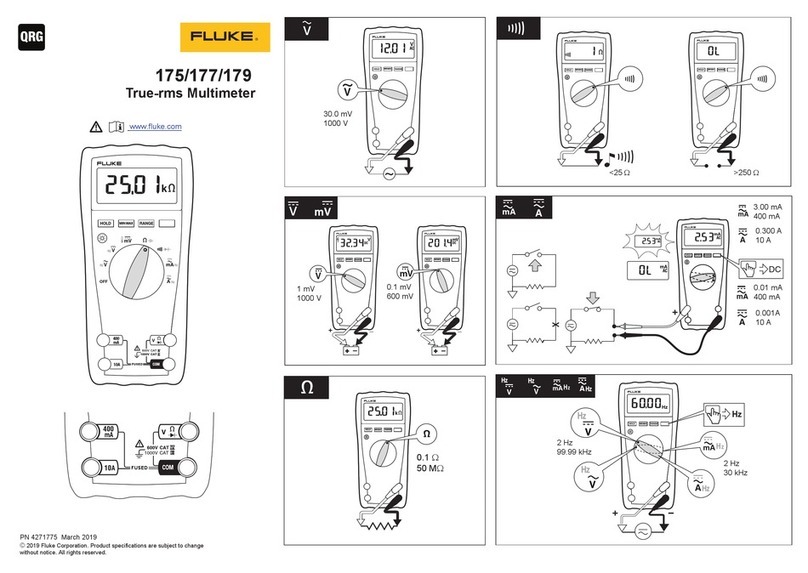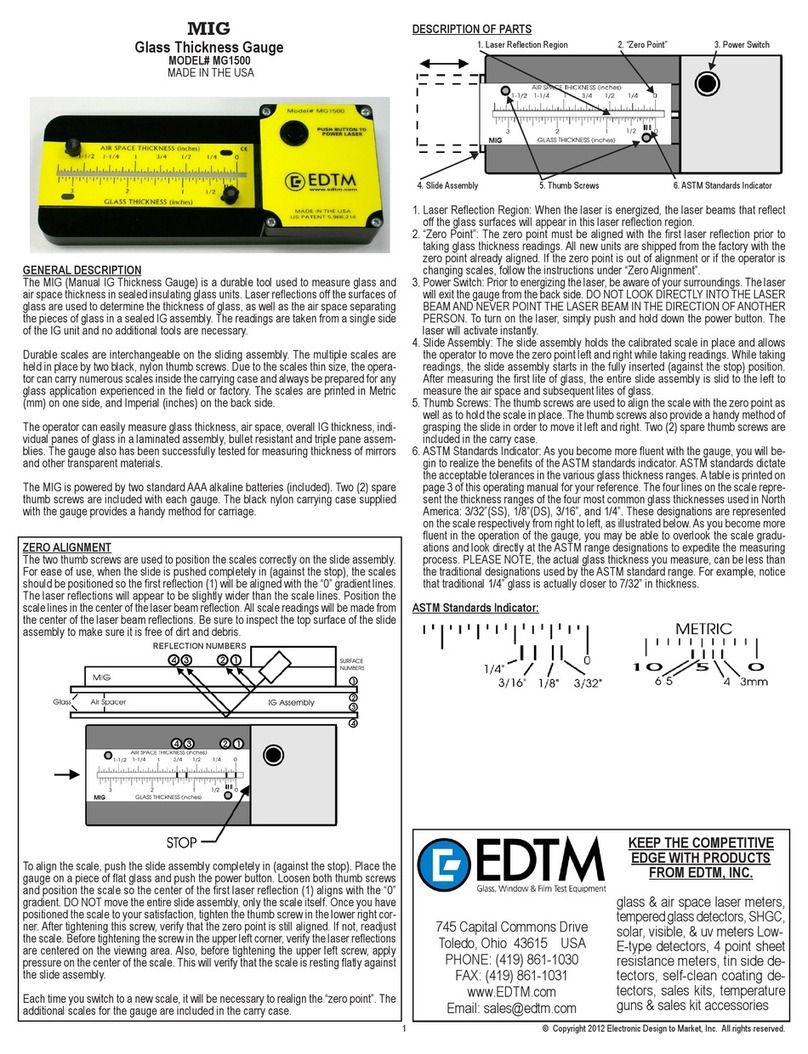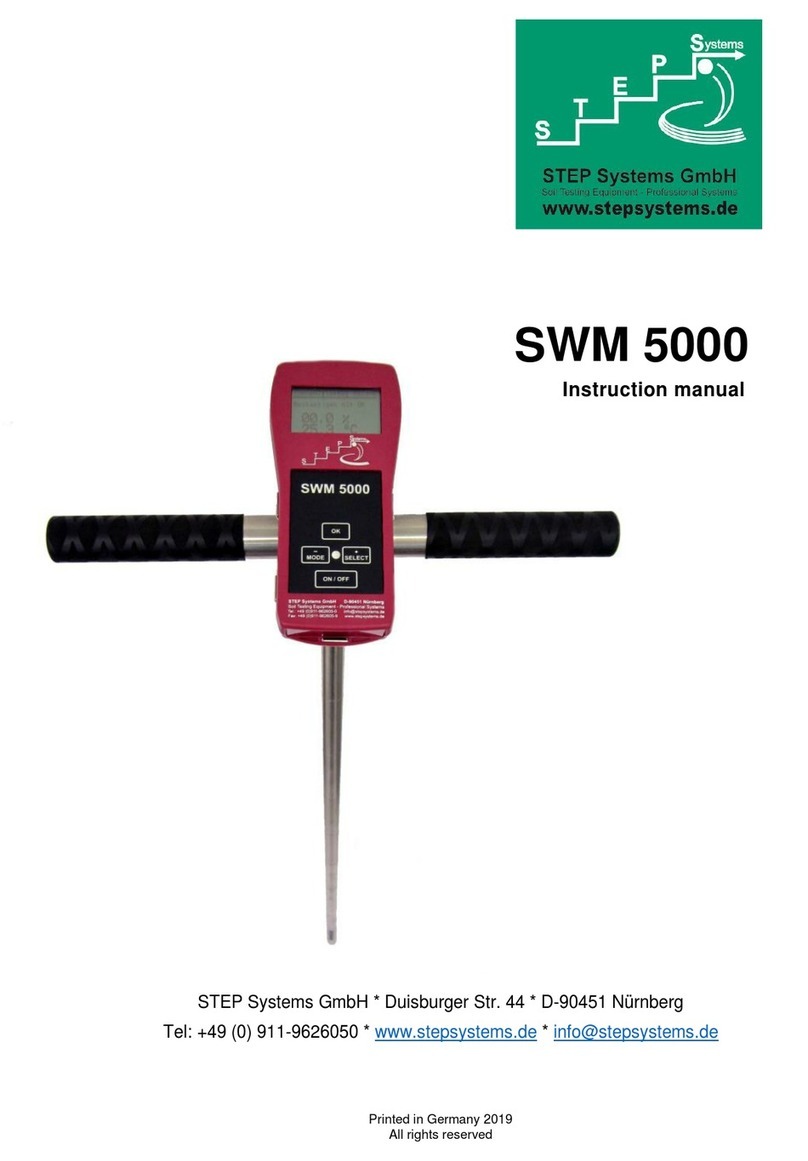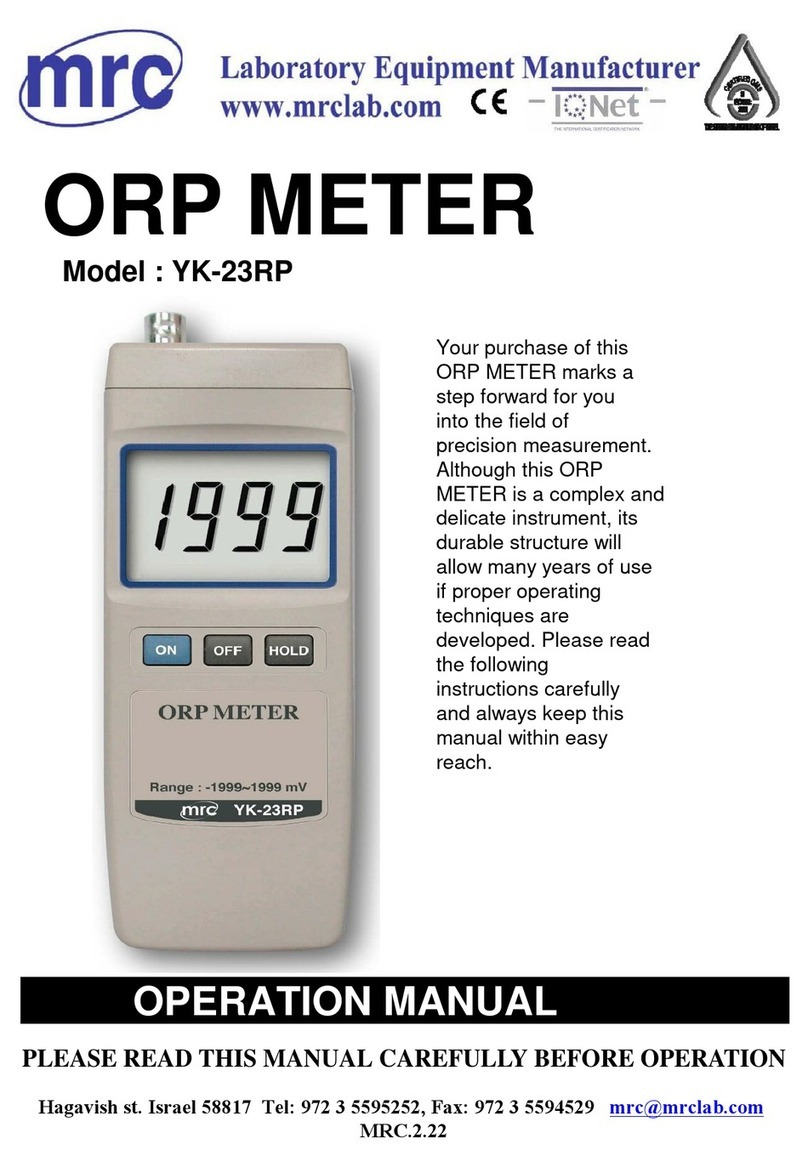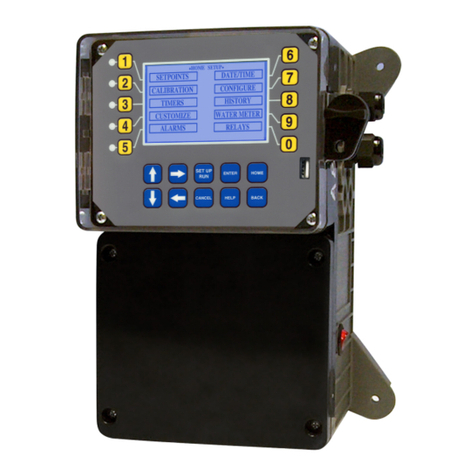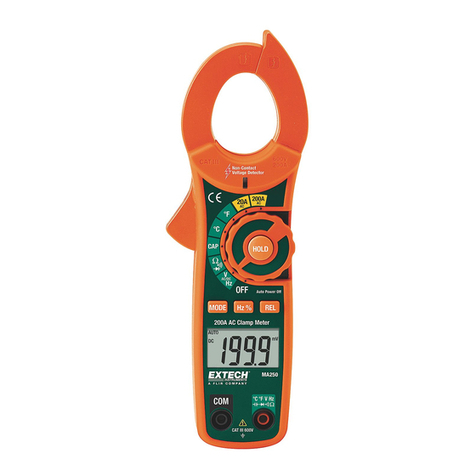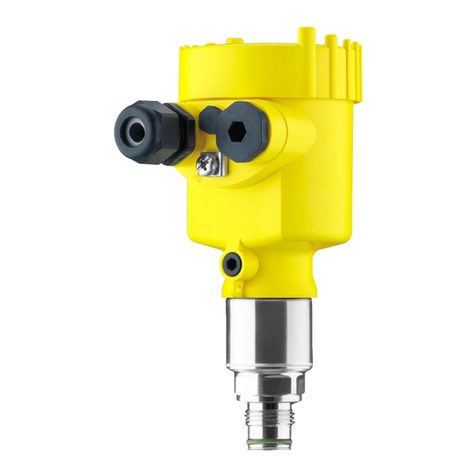Datum DTR80R User manual

ROTARY LASER
DIAL-IN DUAL GRADE
MODEL NO.: DTR80R DTR80G
OPERATING
INSTRUCTIONS
TO PREVENT SERIOUS INJURY, READ
AND UNDERSTAND ALLWARNINGS
AND INSTRUCTIONS BEFORE USE.

2ROTARY LASER LEVEL
TABLE OF CONTENT
SPECIFICATIONS ........................................................................................................3
HAZARD SIGNAL WORD DEFINITIONS .................................................................3
GENERAL SAFETY RULES FOR OPERATION .........................................................4
CONTENT CHECKLIST ...............................................................................................5
COMPONENT OVERVIEW .........................................................................................6
LASER CONTROL DESCRIPTION .............................................................................7
DETECTOR CONTROL DESCRIPTION ....................................................................8
PREOPERATION SET UP ..........................................................................................9
OPERATION LASER INSTRUMENT........................................................................10
USING REMOTE FOR DIAL IN GRADE ....................................................................12
OPERATION LASER DETECTOR.............................................................................12
CALIBRATION CHECK................................................................................................13
MAINTENANCE AND SERVICE.................................................................................13
TROUBLESHOOTING .................................................................................................14
PRODUCT LABELS......................................................................................................14
OPTIONAL ACCESSORIES ........................................................................................15
WARRANTY INFORMATION .....................................................................................16

3OPERATING MANUAL
ABOUT YOUR LASER LEVEL
Thank you for purchasing this DATUM Dual Grade Rotary Laser. Your instrument features extra
bright laser technology, motorised self-levelling, manual grade, dial-in grade on both X and Y
axis and much more.
Please read and understand the content of this instruction manual before using this product.
Save this manual for future reference.
SPECIFICATIONS
MODEL DTR80R DTR80G
BEAM COLOUR Red Green
LASER CLASS Class 3R Class 3R
LASER WAVELENGTH 635nm 520nm
ACCURACY ±1 mm at 30m
OPERATING RANGE (WITH DETECTOR) Ø800m
AUTO LEVELLING RANGE ±5°
BATTERY LIFE (CONTI. OPERATION) 20 Hours 15 Hours
POWER SUPPLY 4 x C-cell 1.5V batteries
4 x Ni-MH 1.2V 4000 mAh rechargeable batteries
Ni-MH BATTERY CHARGER (INDOOR) Input:100-240V~, 50/60Hz Output: 5.6V, 900mA
LINE PATTERN 360° Rotating Line
PLUMB DOTS Up and Down (Red) Up (Green) and Down (Red)
IP RATING IP65
TRIPOD THREADS 5/8” on side and base for horizontal and vertical operations
REMOTE CONTROL DT100RM
DETECTOR DT05REC DT06REC
DATUM is constantly improving its products. All information in this manual is based on the latest product information available at the time of
printing. The specications outlined herein are subject to change without prior notice or obligation.
HAZARD SIGNAL WORD DEFINITIONS
!Indicates an imminently hazardous situation which, if not avoided, will result
in death or serious injury. Obey all safety messages that follow this symbol to
avoid possible injury or death.
DANGER Indicates an imminently hazardous situation which, if not avoided, will result
in death or serious injury.
WARNING Indicates a potentially hazardous situation which, if not avoided, could result
in death or serious injury.
CAUTION Indicates a potentially hazardous situation which, if not avoided, may result
in minor or moderate injury.
CAUTION Used without the safety alert symbol indicates a potentially hazardous
situation which, if not avoided, may result in property damage.
!
!
!

4ROTARY LASER LEVEL
GENERAL SAFETY RULES FOR OPERATION
WARNING
Read all safety warnings, instructions, illustrations and specications
provided with this instrument. Failure to follow all instructions listed below
may result in personal injury.
Save all warnings and instructions for future reference.
•Do not stare into beam regardless of distance.
•Do not use the laser intensive glasses as safety goggles, sunglasses or when driving.
•Do not point laser in the direction of other people or animals.
•Do not point laser in the direction of mirrors or other reective surfaces.
•Store in a secure location with the tool case provided when not in use.
•This is a quality precision measuring device and is 100% factory adjusted within the stated
tolerance.
•Laser should not be used as a toy or by children.
•Do not view beam through optical instruments such as theodolites, binoculars, cameras or
magnifying lenses.
•Avoid using laser in darkened areas. Ensure sucient light levels to avoid damage to eyes.
•Set up the instrument to ensure laser beam path is above or below eye level.
•Ensure the instrument is securely set up to avoid accidental movement.
•Always ensure the laser beam is aimed at a sturdy work piece without reective surface.
Bright shiny reective sheet steel or the like is not suitable for laser use as the reective
surface could direct the beam back at the operator.
•Do not break up or throw the battery into re, please recycle the battery after use.
•Turn the instrument o when it is not in use. Leaving the laser on increases the risk of
staring into the laser beam.
•Do not use or store the instrument in locations where the temperature may reach or
exceed 40°C.
•Never use supplied charger to charge alkaline batteries. It’s only designed for charging
the Ni-MH battery pack supplied with the unit.
•Never set laser level on a surface with heavy vibrations or in territories where heavy
apparatus is being worked.
•High mechanical stress, high ambient temperatures or immersion into uids can cause
leakage, re or explosions of the batteries.
•Do not disassemble the instrument or attempt to perform any internal servicing as this will
void your warranty. Not user serviceable parts included. Only approved and authorised
service technicians can carry out warranty repairs.
•Avoid direct eye exposure. Consult your laser safety ocer or IEC 60825.14:2011 Part 14 for
best operating practice.
CAUTION Class 3R laser product according to IEC 60825-1:2014.
Avoid direct eye exposure. Do not direct it towards other people.
!
!

5OPERATING MANUAL
CONTENT CHECKLIST
1
2 3 4
5
6
107 8 9
1. Heavy duty tool case with EVA foam
2. 100m Remote control with LCD screen
3. Millimetre laser detector
4. Dual grade rotary laser
5. Ni-MH battery charger (indoor only)
6. Alkaline battery pack
7. Sta mounting bracket for detector
8. Laser glasses
9. Laser target
10. Ni-MH battery pack

6ROTARY LASER LEVEL
COMPONENT OVERVIEW
1. Metal Lighthouse
2. Rotating laser module
3. Laser control panel
4. Up plumb dot output window
5. Rubber feet - for vertical operation
without tripod
6. 5/8” Tripod thread - for vertical operation
7. Battery compartment
21
3
78
9
5
8. Battery charging jack
(for Ni-MH battery only)
9. Down plumb dot output window
with 5/8” tripod thread - for horizontal
operation
10. Signal output window
11. Digital screen for dial-in grade
12. Remote control panel
4
6
10
11
12

7OPERATING MANUAL
LASER CONTROL DESCRIPTION
BUTTON DIRECTION OF USE
A - Counter-clockwise
Rotation Control
In scanning mode, press this button to move the scanning beam in a
counter-clockwise motion.
B - Clockwise Rotation
Control
In scanning mode, press this button to move the scanning beam in a
clockwise motion.
C - RPM Speed Control When a slower speed is required for visibility, adjust the speed by pressing
RPM button. There are 5 rotation speeds to choose from: 0 - 60 - 120 - 300
- 600
D - Scan Mode The scan mode allows the laser beam to emit only in a restricted radius
forming a horizontal line. There are 5 width of scanning motions choose
from: 0° - 10° - 45° - 90° - 180°
To move the line, press Rotation Control button (A and B).
To exit the scan mode, press the RPM button (C).
E - Tilt Alarm/Wind Mode Press once to activate Tilt Alarm mode.
Press again to switch to Wind Mode.
F - Manual/Auto Control When the power is on, the laser starts with Automatic Mode. Switch to
Manual Mode for grading slopes. The LED indicator light is on when Manual
Mode is active.
G - Grade Adjustment In Manual Mode, these two buttons allow you to adjust grade on X axis.
H - Grade Adjustment In Manual Mode, these two buttons allow you to adjust grade on Y axis.
Laser Power Button Press the On/O button to turn on the laser.
The instrument always starts up in Automatic mode and begins self-
levelling if it’s set up within 5° range (horizontal or vertical). Switch to
Manual mode by pressing button (F).
A
C
E
B
D
F
G
H
G
I

8ROTARY LASER LEVEL
DETECTOR CONTROL DESCRIPTION
BUTTON DIRECTION OF USE
I - On/O Detector On/O button.
J - Volume Control O-Medium-High
K - Units Selection/Screen
Backlight
Unit Selection - Press the button to switch dierent unit for readings:
cm, mm, in and ft.
Screen Backlight - Press and hold this button for 3 seconds to activate the
backlight for extra visibility.
L - Accuracy Setting Change detection accuracy.
LED INDICATOR DESCRIPTION
ORANGE Indicates the laser beam is above the leveled line
GREEN Indicates the laser beam is on grade with the levelled line
RED Indicates the laser beam is under the levelled line
3
4
1
5
2
I
1. Speaker
2. LED indicator lights
3. Bubble level
4. Laser sensor panel
5. LCD screen
6. Sta mounting
bracket
6
J
K
L

9OPERATING MANUAL
PRE-OPERATION SET UP
POWER SUPPLY
Alkaline Battery Pack
•Your instrument requires 4 C-cell batteries. Use only new, high-quality battery for best
results.
•Locate battery compartment at the bottom of the laser. Insert batteries into the carrier
according to the symbols and polarity then place it into the battery compartment.
•When the battery voltage is low, the power indicator light will start ashing in which the
batteries must be replaced.
•Once the voltage is below 3.9V, the unit will shut o automatically due to low battery.
Ni-MH Battery Pack
•Your laser is supplied with a rechargeable Ni-MH battery pack and a battery charger.
•Place Ni-MH battery pack into the battery compartment. Charge the battery via charging
port (one on base and one on the side) with the supplied charger (indoor use only).
•Battery indicator light on charger is in red while charging. Once the battery is charged in
full, the indicator light will turn into green.
•Remove the charger once the battery is full.
•When the battery is running low, all LED indicator lights on the control panel will start
ashing in which the battery pack must be recharged.
WARNING
Only use charger supplied by DATUM to charge the Ni-MH batteries. Using a
battery charger not recommended by DATUM can destroy the batteries.
The charger supplied is indoor use only. Do not charge alkaline batteries.
LOCATION
•Keep the location clear of possible obstructions that could block or reect the laser beam.
•Place the instrument on stable ground. Ground vibration and extremely windy conditions
can aect the operation.
SETTING UP ON TRIPOD
•Attach the instrument securely to a tripod or wall mount on a stable level surface.
See “Optional Accessories”for recommendations.
•Be sure to secure the tripod or wall mount to avoid windy conditions.
LASER PLACEMENT
•HORIZONTAL OPERATION - set up the instrument up right on a stable at surface, tripod or
wall mount. Ensure the instrument is set up within ±5°.
•VERTICAL OPERATION - lay the instrument on its back on a stable at surface, tripod or wall
mount. Ensure the instrument is set up within ±5°. This can be used for vertical alignment
of form work, pipelines and etc.
!

10 ROTARY LASER LEVEL
OPERATION - LASER INSTRUMENT
ON/OFF
Press the power button to turn on the instrument. Once it’s on:
•The instrument always starts up in Automatic Mode and begins self-levelling if it’s set up
within 5° range (horizontal or vertical). During self-levelling, laser beam ashes before it
starts spinning.
•Once it’s self-levelled, laser head will start to spin, emitting a rotating laser beam pattern.
•If the instrument is bumped or senses interference, the laser head will stop spinning
and re-level. Once unit has re-levelled, the laser head will begin to spin again, emitting a
rotating laser beam pattern.
•If the instrument is outside of the 5° range, it will not level causing the laser beam to ash
continuously. Reposition your instrument within the range until the instrument can re-
level.
Note: If the unit has been bumped or moved and the laser recommences spinning the instrument may not
be at the original level position. Please recheck your RL/datum point.
RPM SPEED CONTROL
Rotation speed can be controlled by pressing RPM button on the instrument. In automatic
mode, laser rotation speed starts at 600rpm. Adjust the speed from 600rpm - 0rpm - 60rpm -
120rpm- 300rpm - 600rpm.
SCAN MODE
The scanning mode allows the laser beam to emit only in a restricted radius forming a horizontal line within
180°. There are 5 levels to choose from: 0° - 10° - 45° - 90° - 180°.
•Turn on the instrument and allow self level.
•Press the SCAN button to active scan mode. Laser starts with 0° when entering scan mode.
•Adjust the scan width by pressing scan button.
•To move the scan line, utilise the rotation control buttons.
•To exit the scan mode, press RPM button and the laser will begin to self-level and rotate
again.
ROTATION CONTROL
In scan mode:
•Press the counter-clockwise rotation button to move the laser line to the left.
•Press the clockwise rotation button to move the laser line to the right.

11OPERATING MANUAL
MANUAL MODE GRADE SLOPE MODE
Your rotary laser has an incorporated grade slope function to manually set grades/slope up
to 8% on X and Y axis.
•Turn on the instrument and allow self level. Then press AUTO/MAN button the instrument
active manual mode.
•Manual mode indicator light is on when it’s activated.
•In manual mode, the self-levelling will be deactivated for grading slope.
•Press AUTO/MAN button again to turn o manual mode and return to automatic self-
levelling mode.
HOW TO USE MANUAL MODE
Once laser is levelled and spinning, press the AUTO/MAN button to activate manual mode.
•Use the left and right arrows to adjust the slope of the laser along the X axis
•Use the top and down arrows to adjust the slope of the laser along the Y axis
•To return to the auto-level mode, press the AUTO/MAN button again.
Note: When in manual mode, the laser will not self level.
TILT ALARM
Once the instrument is automatically levelled. Tilt Alarm can be activated by pressing the tilt
alarm button (E). This function becomes active and monitors the movement of the laser
30 seconds after it’s completely levelled and starts rotating.
This is used to prevent incorrect work or readings caused by movement.
•When activated, tilt alarm indicator light ashes continuously.
•If the instrument is knocked or interfered with while the alarm is activated, the laser will
stop rotating and start ashing. In this case, check and adjust the instrument set up. It’s
also recommended to check DATUM point when the unit re-levels.
•Reset the instrument by turning it o then back on. Or press TILT/WIND button twice to
deactivate the alarm.
WIND MODE
Your instrument comes with a built in Wind Mode feature to assist with levelling in high wind
conditions. When Wind Mode is activated, the laser will continue to self-level without cutting
out when interfered by high wind, vibration or slight movement.
•To active wind mode, press TILT/WIND button twice. When activated, the indicator light
right next to WIND will light up.
•To turn o wind mode, press the button again to deactivate this function and return to
self-levelling mode.
Note: Tilt Alarm and Wind Mode cannot be used simultaneously as they function in the
opposite way.

12 ROTARY LASER LEVEL
USING REMOTE FOR DIAL IN GRADE
Your instrument comes with an digital wireless remote which allows you to set up dial-in grade
at a distance up to 100m.
Turn on the instrument and allow self-level. Turn on the remote and
allow them to sync.
To create a dial-in grade with the remote:
•Press“GRADE” button on the remote control to activate dial-in
grade. The remote screen will show the dial-in function for X and
Y axis with X axis selected.
•Setting desired grade by pressing button “+” and “-” on the
remote control. It’s designed to grade with increment of 0.1%.
•To grade Y axis, press “X/Y” once to switch to Y axis and adjust by
pressing “+” and “-” on the remote control.
•Once your desired grade is set up, press “GRADE” again. The laser
head will stop spinning for a few seconds and adjust its slope to
the grade then start spinning.
•Exit Grade Mode by pressing“GRADE” button again. The instrument will switch back to
Automatic Mode and begin self-levelling. Levelling icon on remote will start blinking while
it’s self-levelling.
For other operation controls such as RPM speed control, scanning mode and rotation control,
refer to previous section for details.
OPERATION - LASER DETECTOR
Your detector uses 4 x AA 1.5V batteries. Locate battery compartment at the back of the
detector and insert batteries according to the symbols and polarity.
Mounting the sta clamp to the detector via the 1/4” thread on the back.
•Switch the detector on by pressing the power button.
•The LCD screen will display the battery level, accuracy setting and speaker mode.
•Press button (L) to change between dierent accuracy settings.
•Move the detector into the path of the laser beam.
•Hold the detector upright for horizontal beams or rotate the detector 90° for vertical
beams.
•The direction arrows or level line on the LCD screen will indicate the position of the laser
beam. The detector will emit a constant beep once the level position has been located.
WARNING
If the product is used with accessories, for example masts, staves, poles, you
may increase the risk of being struck by lightning.
Do not operate the product in a thunderstorm.
!

13OPERATING MANUAL
CALIBRATION CHECK
It’s possible for you to check the calibration of the laser. It’s recommended to check the
calibration of the laser before performing any levelling task. Calibration by yourself is only
approximate and the accuracy of the calibration will depend on the care with which you
proceed.
•Place the instrument on a at, level surface or a tripod 30m away from a wall or sta with a
detector.
•Align the rst axis so that it’s square to the wall or sta. Allow the laser to self level
completely.
•Mark the position of the beam on wall or note the position of the beam from sta (P1).
•Rotate the instrument 180° and allow the instrument to self level again.
•Mark or note the position of the beam (P2).
•Rotate the instrument 90° and align the second axis so that it’s square to the wall and
allow the laser to self level completely.
•Mark the position of the beam on wall or note the position of the beam from sta (P3).
•Rotate the instrument 180° and allow the instrument to self level again.
•Mark or note the position of the beam (P4).
•The instrument is within its accuracy specication if the 4 parts are within ±1 mm from the
centre.
MAINTENANCE AND SERVICE
•The instrument is a precision measuring device and should always be handled with care.
•Do not attempt to open the device. To ensure product SAFETY and RELIABILITY, repairs,
maintenance and adjustment should be performed by authorized service centres.
Contact your dealer for more details.
•Do not drop, knock or shake the laser level as this will aect precision.
•Remove batteries when the instrument is not in use.
•Keep the instrument clean at all times. Use a soft lint-free cloth for the body and lens tissue
for glass windows. Do not use abrasive cleaners or solvents.
•Do not store the instrument in the hot areas, hot temperatures can short the life of
electronic device, damage battery, and warp or melt certain plastics.
•Do not store the laser level in the cold areas. When the unit warms up to its normal
operating temperature, moisture can form inside where it may damage circuit board.
•Avoid shock, vibrations, extreme heat and humidity.
•Do not immerse the instrument in water.
•Always turn the instrument OFF when storing, transporting or moving around the job site.
•Calibration is recommended at least once a year or as needed.
•When transporting the instrument, always make sure that it’s carried in its original tool
case. Never carry the product loose in a road vehicle.

14 ROTARY LASER LEVEL
TROUBLESHOOTING
ISSUE POSSIBLE CAUSE AND SOLUTIONS
Laser does not turn on
Check batteries. Make sure batteries are installed according to the
correct polarity.
The batteries may be low or depleted. Make sure the batteries are in
proper working condition. If in doubt, try installing new batteries.
If the laser has been stored in extremely hot temperatures, allow it to
cool.
Laser does not level
Instrument may be outside it’s levelling range. Position the
instrument, tripod or the base surface.
Instrument may have impact damage. Contact service centre for
repair and calibration.
Instrument may be outside its self-levelling range. Adjust the position
within the self-levelling range.
Instrument may be in Manual Mode. The laser must be in Automatic
Mode to self level.
Laser beam distance is reduced Dirt and dusty condition can reduce the visibility of the laser beam.
Clean the laser output window.
Laser head does not rotate Instrument may be levelling or in Wind Mode. Refer to“Direction of
U s e ”.
Laser detector is not working
properly
The detector may be low in battery. Replace batteries and install
according to the correct polarity.
The detector may be out of usable range. Move the detector closer to
the instrument.
PRODUCT LABELS
DTR80R DTR80G

15OPERATING MANUAL
OPTIONAL ACCESSORIES
DATUM oers a range of accessories that are compatible with our laser levels. They can be
purchased separately and add more exibility to get your job done.
HEAVY DUTY WALL BRACKET (DT05AC)
DOME HEAD LASER TRIPOD (DT1730D) FLAT HEAD LASER TRIPOD (DT1730F)
5M E-FACE STAFF (DT5ME) 5MM-FACE 5 SECTION STAFF (DT5MCM)
Maximum height:
1730mm
Minimum Height:
1010mm
Maximum height:
1730mm
Minimum Height:
1010mm

July 12, 2019 11:57 am
WARRANTY INFORMATION
This warranty is provided by DATUM of 20 Thackray Road, Port Melbourne VIC 3207.
Phone: 1800 868 258.
Express Warranty
Subject to the exclusions set out below, we warrant that this product will be free from defects
in materials or workmanship for 3 years (90 days for accessories, batteries and chargers) from
the date of purchase.
The benets conferred by this warranty are in addition to all rights and remedies which you
may be entitled to under the Australian Consumer Law, and any other statutory rights you may
have under other applicable laws. This warranty does not exclude, restrict or modify any such
rights or remedies.
Warranty exclusions
This express warranty does not apply where a defect or other issue with the product is caused
by normal wear and tear, misuse or abuse of the product.
Consumer guarantees
Our goods come with guarantees that cannot be excluded under the Australian Consumer Law.
You are entitled to a replacement or refund for a major failure and for compensation for any
other reasonably foreseeable loss or damage.
You are also entitled to have the goods repaired or replaced if the goods fail to be of acceptable
quality and the failure does not amount to a major failure.
Warranty claims
To make a claim under this warranty, you must bring the product along with the proof of
purchase and any other documentary evidence which you think is relevant to the your place of
purchase where the claim will be handled on our behalf during the warranty period specied
above. Any cost incurred by you in bringing the product to the place of purchase will be borne
by you.
Calibration and repair service
Datum recommends to check instrument calibration at least once a year or on as needed
basis. For calibration or repair service (not covered under warranty), please visit your place of
purchase.
This manual suits for next models
1
Table of contents
Other Datum Measuring Instrument manuals
